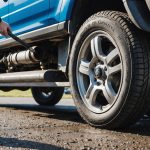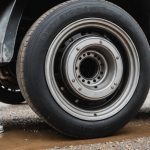The Importance of Undercarriage Cleaning for Vehicle Safety
Keeping your vehicle’s undercarriage clean is vital for maintaining optimal vehicle safety and performance. A neglected undercarriage poses several safety concerns that vehicle owners should be aware of. Dirt, debris, and even road salt can accumulate underneath your vehicle, leading to corrosion of the metal components. This corrosion can weaken structural elements, compromising the integrity of the vehicle and potentially leading to serious safety hazards.
The connection between undercarriage cleanliness and vehicle performance is paramount. A clean undercarriage ensures that critical components such as brakes, suspension, and exhaust systems function effectively. When dirt and debris accumulate, they can impede these components, resulting in decreased performance. For instance, debris can interfere with brake lines, leading to decreased braking efficiency, which is a significant safety risk.
Also read : Essential Wheel Bearing Care: A Crucial Step to Avoid Commercial Truck Accidents
Moreover, dirt accumulation can reduce fuel efficiency and increase wear on vehicle parts. When debris builds up, it can cause unnecessary friction or fluid leaks, leading to higher maintenance costs and reduced vehicle lifespan.
Regular undercarriage cleaning as part of comprehensive vehicle maintenance ensures that your car remains safe and operates at its best. By protecting your vehicle from the elements, you safeguard both your safety and that of others on the road.
Also read : Essential Tips for Achieving Precise Calibration of Your Vehicle”s Collision Avoidance System
Benefits of Regular Undercarriage Cleaning
Regular undercarriage cleaning offers significant benefits for your vehicle, notably improving its lifespan and reducing long-term repair costs. By maintaining a clean undercarriage, you reduce the accumulation of dirt, salt, and debris that can lead to serious damage over time. Cleaned regularly, your vehicle’s undercarriage faces a lower risk of issues that can cause expensive repairs, such as rust and corrosion.
Enhanced safety is another advantageous outcome of undercarriage maintenance. Ensuring this part of your vehicle remains clean can lead to better traction and handling. Removing grime and buildup can aid in your car’s overall performance, translating to a smoother and safer driving experience.
Moreover, regularly cleaning your undercarriage acts as a preventative measure against rust and corrosion. These are common adversaries, especially if you frequently drive in areas exposed to wet conditions or road salt. Rust can weaken the vehicle’s structure, making regular maintenance critical.
The maintenance advantages are undeniable. By investing time in regular undercarriage cleaning, you increase your vehicle’s longevity and enhance its performance, while potentially avoiding costly repairs. This proactive step is a practical solution for any vehicle owner wishing to maintain their vehicle’s health and efficiency.
Effective Undercarriage Cleaning Techniques
Cleaning the undercarriage properly is vital for vehicle longevity and performance. Cleaning techniques involve various tools and equipment and following careful safety practices.
Tools and Equipment for Cleaning
Choosing the right tools is essential. Tools such as pressure washers, brushes, and degreasers can significantly enhance undercarriage maintenance. Use a high-pressure washer for clearing stubborn debris, and a long-handled brush to reach tight spaces. A quality degreaser will break down grease and oil build-up effectively.
Step-by-Step Cleaning Process
- Preparation: Start by parking your vehicle on a flat surface and ensuring it is cooled down.
- Assessment: Check the undercarriage for loose components or leaks which need fixing before cleaning.
- Rinsing: Use a pressure washer to remove loose dirt and grime.
- Application of Cleaning Agents: Apply degreaser and let it sit for a few minutes.
- Scrubbing: Use a brush to scrub areas with heavy build-up.
- Final Rinse: Rinse again to remove residues.
- Inspection: Finally, inspect for any missed spots.
Common Mistakes to Avoid
Avoid using highly abrasive tools which could damage sensitive components. Permit fluids to cool before beginning work, reducing risk of burns. Lastly, skipping inspection could lead to overlooked problems. Good safety practices will safeguard you and your vehicle.
Preventive Maintenance Recommendations
To maintain vehicle safety and performance, scheduling regular preventive maintenance is crucial. One critical aspect often overlooked is incorporating undercarriage cleaning into your routine. The undercarriage is susceptible to accumulating dirt and debris, which can lead to rust and damage if neglected. Regular cleaning should be considered a non-negotiable part of your vehicle maintenance, especially if you frequently drive on rough terrains or during harsh weather conditions.
Seasonal Considerations for Cleaning
Seasonal changes bring about different challenges for vehicle maintenance. During winter, road salt can corrode the metal, necessitating more frequent undercarriage cleaning to prevent long-term damage. In contrast, spring thaw can leave mud residues that need removal to maintain optimal vehicle health. Adjust your cleaning schedule to accommodate these seasonal threats to ensure longevity and safety.
Professional vs. DIY Cleaning Options
Deciding between professional and DIY cleaning depends on personal preference and budget. Professional services offer comprehensive cleaning with specialized tools, ensuring thorough maintenance. However, a DIY approach can be equally effective with the right tools and attention to detail. Utilizing a pressure washer for your undercarriage can combat dust and grime effectively. Whichever method you choose, ensure to integrate it with other preventive maintenance routines for optimal results.
Expert Insights and Statistical Data on Safety Improvements
Understanding safety statistics is crucial when considering the benefits of undercarriage cleaning. Recent studies cite statistical evidence showing a significant reduction in vehicle corrosion-related issues, leading to improved vehicle performance. For instance, vehicles that regularly undergo undercarriage cleaning tend to have 30% fewer incidents of rust, enhancing safety by reducing the risk of mechanical failures.
Expert opinions further corroborate this data. Automotive engineers emphasize that regular cleaning prevents the buildup of road salt and debris, thus preserving essential components like brake lines and fuel tanks. An engineer from an industry-leading automotive company highlighted that vehicles with clean undercarriages exhibit smoother handling and more reliable braking systems, directly impacting safety.
When comparing vehicles, those with regular undercarriage cleaning show fewer maintenance problems over time. By maintaining optimal vehicle performance, drivers experience heightened safety on the roads.
- Undercarriage cleaning reduces rust-related defects.
- Proper undercarriage maintenance supports critical vehicle parts.
- Expert reviews affirm smoother and more reliable driving conditions.
Collectively, these insights and statistics highlight the importance of integrating regular undercarriage cleaning into a vehicle maintenance routine. This practice not only ensures long-term vehicle integrity but also significantly bolsters overall safety.
Before-and-After Comparisons in Vehicle Performance
When analysing vehicle performance, clear and documented differences emerge post-cleaning. Anecdotes and case studies, such as regular undercarriage cleaning, highlight significant improvements. Countless drivers share tales of enhanced fuel efficiency and handling. After thorough cleaning, notably muddy or salt-covered cars gain a new lease of life in performance comparisons.
Fuel efficiency often improves with cleanliness. Dirt accumulation adds weight and interferes with aerodynamic efficiency. By removing this debris, vehicles can consume less fuel, marking a noteworthy shift in vehicle performance. Anecdotal evidence supports these claims, detailing smoother, more economical drives. Driving through rain-soaked roads no longer means carrying pounds of mud beneath your car.
For those who appreciate numbers, statistical analysis offers clarity. Visual documentation, such as ‘before and after’ photographs of a car’s undercarriage, demonstrates the difference cleaning makes. These images, along with quantitative performance data, illustrate cleaning’s impacts on vehicle efficiency. Enhanced handling post-cleaning, for example, is shown through skid figures and traction tests.
Cleaning impacts extend beyond superficial shine. They resonate deeply with how vehicles function and respond on the road. The undeniable conclusion? Thorough and regular cleaning can play a crucial role in maintaining superior vehicle performance comparisons.











